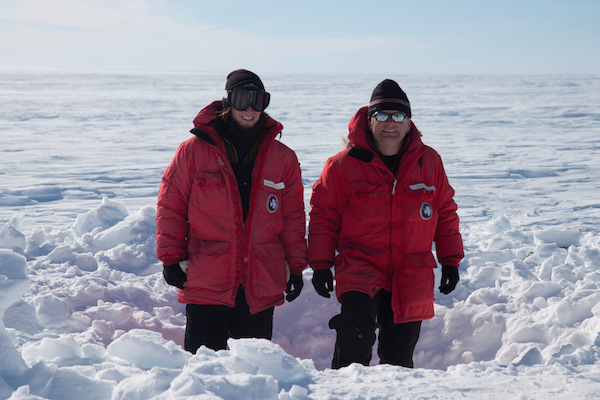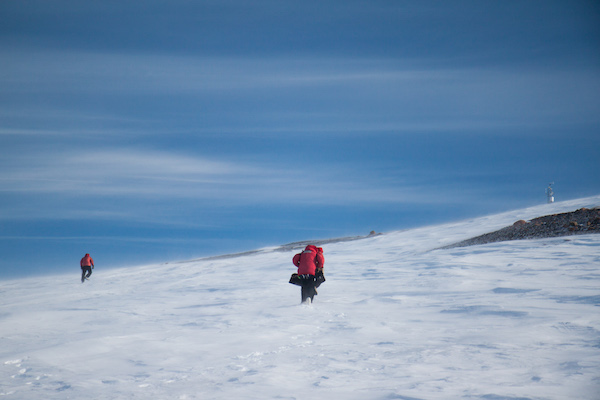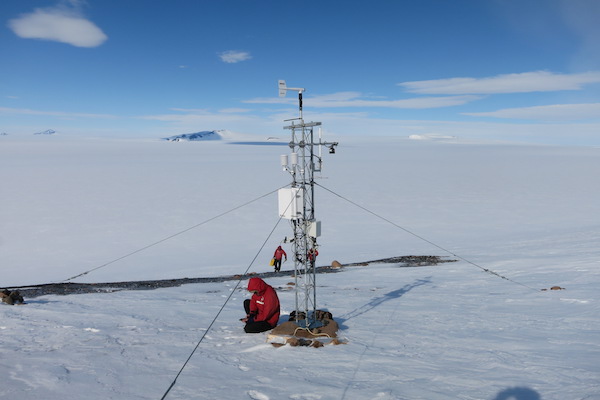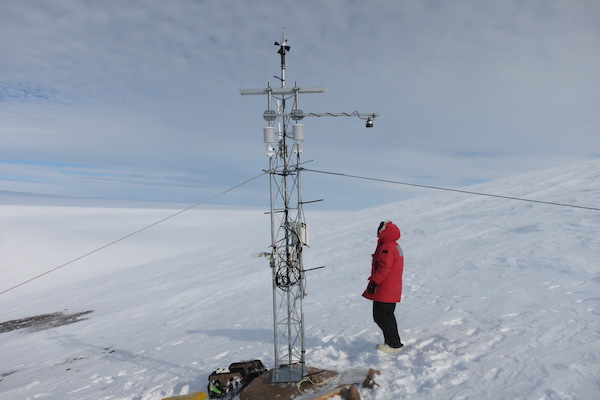Dec 11 – Friday
The past few days have been busy ones for Mark and I. First, we have been on the flight schedule to leave WAIS on an LC-130 back to McMurdo on Wednesday night, Thursday night, and now tonight. We are still at WAIS because the plane couldn’t come Wednesday due to mechanical issues, nor could it come last night because of crew availability. It is scheduled to come tonight at 9:30 pm local time.
While we’ve been on the LC-130 schedule, we’ve also been on the Twin Otter here. It has been possible for us to still do field work because the LC-130 flights have been scheduled to arrive at WAIS around 7 pm or later.
On Wednesday, Mark and I flew with Paul Koubek (mountaineer) and Joel Gombiner (geologist) to Brianna AWS (to remove) and Erin AWS (to raise). Paul came with us because Brianna was installed near several crevasse fields. Joel came with because we had extra room and could use the extra hands for digging and other tasks in the field.
Brianna was installed in 1994 but had not been visited sine 2002 because pilots had not wanted to land among the crevasse fields. At the beginning of this field season, I spoke with Brad, from the Polar Geospatial Center, in McMurdo to get high-resolution satellite imagery of some of our more precariously located AWS, including Brianna. He was able to get me a couple images of Brianna, one with a 20-km range and one with a 2-km range. The 20 km image showed several crevasse fields, that honestly look pretty nasty, surrounding Brianna AWS. The 2 km image, however, did not show any evidence of crevasses. At WAIS, after discussing this with the pilots and with Paul, we decided that it should be safe enough to land right next to the AWS and not have to worry about crevasses (Twin Otter planes are able to land in a very short distance).
We landed at Brianna AWS without any problems and got right to digging out the station. With everyone, including the pilots, helping to dig, we were able to remove all the instrumentation, a battery box, and the top tower section in just over an hour. This gave us plenty of time to go to Erin AWS.

Brianna AWS when we arrived. It’s short, but after almost 14 years since its last visit, it’s not too bad!

We removed (almost) all trace of Brianna. And when given an opportunity to have a picture taken of you standing in a hole, you take it.
At Erin, which has a gorgeous view of the Transantarctic Mountains, we noticed that the station did not need to be raised. It was plenty tall, so all we needed to do there was raise the enclosure.
On Thursday we flew by Twin Otter to Evans Knoll AWS. Our goal for this visit was to fix the anemometer and pressure sensor, both of which weren’t transmitting. We had tried to visit this site about a week earlier but were unable to land due to flat light. This time, it was nice and sunny when we landed. The wind, however, was roaring. It was a sustained 25 to 30 knots! We needed to climb up a fairly steep hill to get to the AWS, and the wind made it that much more difficult. At least it was a balmy 30 degrees F.

It was a fairly steep walk from the Twin Otter up to the AWS. That coupled with the winds made it very tiring, as Paul (left) and I realized.
The anemometer was a simple fix; the nose cone and propeller were missing due to the very high winds. We were unable to fix the pressure sensor on site. One unexpected thing we noticed was that the solar panel was missing too! The high winds must have rattled it loose and flung it off its mount. Without the solar panel, the batteries can’t get charged and will eventually drain. Given this, and that we couldn’t fix the pressure sensor in the field, we decided to power down the station and remove the electronics to bring back with us. This way we can diagnose any issues with the pressure sense in the lab, get a solar panel ready to install, and put everything back at Evans Knoll (hopefully later this field season) without draining the batteries. Because it would not be fun carrying 150 pounds of batteries up that hill!
We were flying back to WAIS when we heard the unfortunate news that our LC-130 flight had been cancelled. It was especially unfortunate because when we got back to WAIS, the weather was gorgeous. Mostly clear skies, low winds, great visibility, and all-around perfect for an aircraft to land.
Today, Friday 11 December, the weather isn’t as good. It’s been pretty windy (~15 knots) all day, with low visibility in blowing snow. Hopefully by tonight the winds will die down so the plane can take us back to McMurdo. After all, we’re scheduled to leave the ice on Monday, 14 December!








